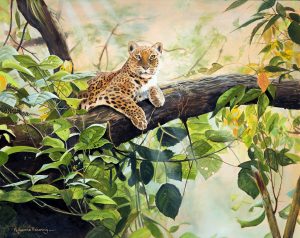Expedition to Brazil to find the Spirit of the Jaguar
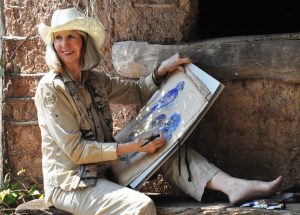 In 2017 Pollyanna fulfilled a long held dream – to visit the Pantanal area of Brazil, to search for jaguars.
In 2017 Pollyanna fulfilled a long held dream – to visit the Pantanal area of Brazil, to search for jaguars.
She faced a grueling journey to get there –instead of flying direct from the UK, she and her daughter and business partner Anna-Louise had to travel from China, where they had been official delegates at the first International Art and Conservation Festival to be held in the country (see page 14). China and Brazil are literally on the opposite sides of the world – so it took 36 hours and four flights to arrive in the far flung town of Cuiaba – known as the gateway to the Pantanal. Once there Pollyanna faced a bone-rattling journey over increasingly rickety wooden bridges to the end of the dusty Transpantaneira highway.
Extending from the Amazon, the Pantanal is the world’s largest tropical wetland. Bigger than England, it stretches across two Brazilian states and into neighbouring Paraguay and Bolivia. A lattice of waterways swells and recedes with the seasons, giving way to vast savannahs and thick “gallery forests” lining the banks. The region remains wild and remote; most parts can only be accessed by tiring, bone-jangling drives along dirt tracks. Teeming with wildlife, the wetland remains a stronghold for the jaguar, whose original habitat has been reduced by almost 40 per cent across Central and South America.
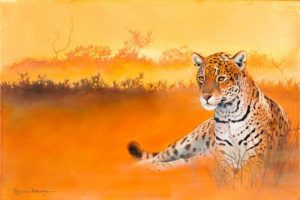 The jaguar is the largest cat in the Americas. They can be found from the harsh deserts of southern Arizona into the lush rainforests of Central America, and from the Pantanal wetlands all the way down to northern Argentina. However in 40% of the jaguar’s original range the big cat has vanished completely, and almost everywhere they are practically impossible to spot – hunting at night, travelling almost invisibly through the dense rainforests. The Pantanal offers a unique opportunity to observe these impressive predators. Here the jaguar is thriving, with an unusually high population, primarily due to the abundance of prey found in the wetlands – including capybara and deer – but also the world’s highest density of caiman (a crocodile-like reptile). The caiman here are so numerous than in places along the banks of the rivers they are almost piled up on top of one another. Jaguars are extremely good swimmers, and very comfortable in the water, and many of the jaguars in this area have become specialists in hunting caiman. This means they have also begun hunting during the daytime.
The jaguar is the largest cat in the Americas. They can be found from the harsh deserts of southern Arizona into the lush rainforests of Central America, and from the Pantanal wetlands all the way down to northern Argentina. However in 40% of the jaguar’s original range the big cat has vanished completely, and almost everywhere they are practically impossible to spot – hunting at night, travelling almost invisibly through the dense rainforests. The Pantanal offers a unique opportunity to observe these impressive predators. Here the jaguar is thriving, with an unusually high population, primarily due to the abundance of prey found in the wetlands – including capybara and deer – but also the world’s highest density of caiman (a crocodile-like reptile). The caiman here are so numerous than in places along the banks of the rivers they are almost piled up on top of one another. Jaguars are extremely good swimmers, and very comfortable in the water, and many of the jaguars in this area have become specialists in hunting caiman. This means they have also begun hunting during the daytime.
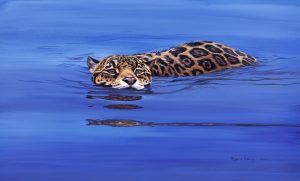 Every day during their stay in the region, Pollyanna and Anna-Louise would get up before dawn, to head out at first light in small motorboats. Within half an hour they would reach the point where three rivers converge, and a network of smaller tributaries spread out. They would spend around six hours on the water under the blistering sun – before heading back to base for a quick bite to eat and then returning to the boats for a further five hours until dusk fell. Often they would find themselves at the end of a narrow channel of water, with shoals of glittering piranha leaping out of the water alongside their boat. But this exhausting schedule was rewarded with numerous sightings of jaguars – on all except one of the boat journeys they spotted at least one of the big cats – and sometimes several in one session! Because the jaguars are very habituated to the boats – they will see them most days along the river banks and know that they neither pose a threat or provide food – they simply ignore them, and continue with their daily lives. This meant Pollyanna could sketch them as they strolled along the banks, rested in the undergrowth – and on several occasions observed them swimming.
Every day during their stay in the region, Pollyanna and Anna-Louise would get up before dawn, to head out at first light in small motorboats. Within half an hour they would reach the point where three rivers converge, and a network of smaller tributaries spread out. They would spend around six hours on the water under the blistering sun – before heading back to base for a quick bite to eat and then returning to the boats for a further five hours until dusk fell. Often they would find themselves at the end of a narrow channel of water, with shoals of glittering piranha leaping out of the water alongside their boat. But this exhausting schedule was rewarded with numerous sightings of jaguars – on all except one of the boat journeys they spotted at least one of the big cats – and sometimes several in one session! Because the jaguars are very habituated to the boats – they will see them most days along the river banks and know that they neither pose a threat or provide food – they simply ignore them, and continue with their daily lives. This meant Pollyanna could sketch them as they strolled along the banks, rested in the undergrowth – and on several occasions observed them swimming.
Pollyanna and Anna-Louise both felt this was the perfect way to observe wildlife. Unlike safaris in Africa, when you can sometimes see the spectacle of a lion being perused across the bush by ten or twelve jeeps desperate for a sighting, here the boats are of course confined to the water. So should a jaguar decide it has had enough of being watched, all the cat has to do is step two feet back into the undergrowth, and it becomes invisible. There are many waterways which are too narrow or shallow for the boats to navigate – the jaguars can hunt along these in complete privacy. However as many of the cats have seen the boats since being cubs, they appear almost oblivious to their presence – happy to stalk, swim, doze, groom and continue their daily lives as though no one is observing them.
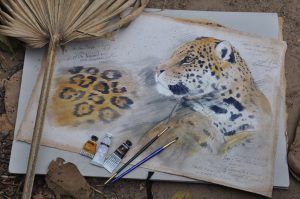 Pollyanna was able to fill her sketchbook with her impressions of the jaguars with their unusually large, round heads, short legs and stunning coats dotted with dark rosettes and spots. She was also lucky enough to be able to spend a couple of hours watching a female jaguar with her cub – and on one heart stopping occasion a huge male jaguar hunting and killing a caiman just a few feet from her boat. “This was an incredibly rare sighting” Pollyanna commented “usually when jaguars hunt caiman it happens in the long growth of reeds, is over in seconds, and almost impossible to observe. But we were watching a male jaguar swimming in the open, when he suddenly came across an eight foot long caiman close to the bank. He began stalking through the shallower waters – but the caiman spotted him, and turned just as he pounced. This meant that instead of being able to grab the back of the reptiles neck and kill it instantly with one bite, as they usually do, the jaguar had to wrestle with the caiman for several minutes – which was the most incredibly dramatic sight to witness as they both reared out of the water, fighting for their lives”.
Pollyanna was able to fill her sketchbook with her impressions of the jaguars with their unusually large, round heads, short legs and stunning coats dotted with dark rosettes and spots. She was also lucky enough to be able to spend a couple of hours watching a female jaguar with her cub – and on one heart stopping occasion a huge male jaguar hunting and killing a caiman just a few feet from her boat. “This was an incredibly rare sighting” Pollyanna commented “usually when jaguars hunt caiman it happens in the long growth of reeds, is over in seconds, and almost impossible to observe. But we were watching a male jaguar swimming in the open, when he suddenly came across an eight foot long caiman close to the bank. He began stalking through the shallower waters – but the caiman spotted him, and turned just as he pounced. This meant that instead of being able to grab the back of the reptiles neck and kill it instantly with one bite, as they usually do, the jaguar had to wrestle with the caiman for several minutes – which was the most incredibly dramatic sight to witness as they both reared out of the water, fighting for their lives”.
Although the jaguars were the main focus of her visit, the Pantanal is teeming with other wildlife, and Pollyanna was able to fill her sketchbooks with images of beautiful hyacinth macaws, coati mundi, and otters, all of which she will be painting for the Spirit of the Jaguar exhibition inspired by her journey, which was posthumously staged in her private gallery in June 2019. She will returned to sketches made on previous visits to Brazil, Argentina and Belize to create new artwork featuring some of the smaller jungle cats – margays, ocelots and even black jaguars.
